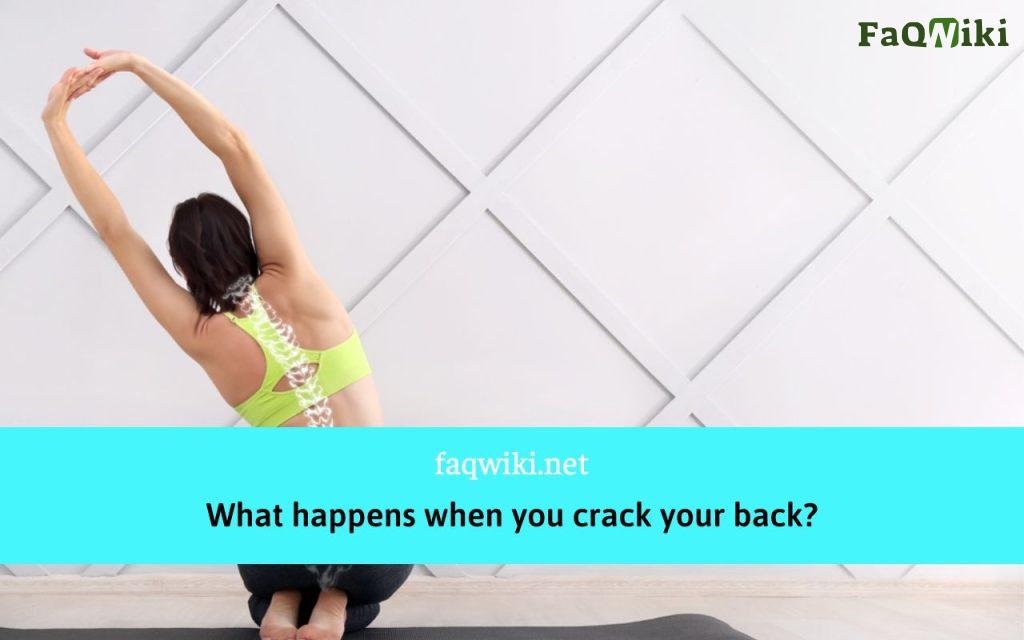What happens when you crack your back?

What happens when you crack your back? Back cracking occurs when the synovial fluid within the joint space creates a gas bubble, which then collapses, creating the popping sound. This can occur as a result of sudden changes in pressure or movement, such as twisting or bending. Joint structure and movement play a key role in back cracking. For example, the facet joints in the spine are flat and allow for a small range of motion, which can result in the release of gas bubbles when the joints move suddenly. Stretching and tension in muscles can also contribute to back cracking, as tight muscles can put pressure on joints and cause them to pop.
Is Cracking Your Back Harmful?
There is some evidence to suggest that cracking your back may be harmful, particularly if it is done excessively or incorrectly. Some studies have linked back cracking to joint degeneration, or osteoarthritis. Additionally, excessive force or twisting of the spine can cause damage to the ligaments and muscles, which can lead to pain and discomfort. It is important to note that the risks associated with back cracking may vary depending on the individual’s overall health, medical history, and age.
The Benefits of Cracking Your Back

What happens when you crack your back?
Despite the potential risks, there are some potential benefits to cracking your back. For example, it may provide temporary relief from tension and pain, increase range of motion, and even provide psychological benefits. Some people may find that cracking their back helps them to feel more relaxed and less stressed. However, it is important to note that the benefits of back cracking are not supported by extensive research, and the practice may not be appropriate for everyone.
Techniques for Cracking Your Back
There are several techniques that can be used to crack your back, including self-manipulation, professional chiropractic care, and the use of tools such as foam rollers or massage balls. Self-manipulation involves using your own body weight and movements to create a popping sound in the spine, while professional chiropractic care involves the use of specific techniques to adjust the spine and release tension. Other tools such as foam rollers or massage balls can be used to target specific areas of the back and provide relief from tension and pain.
Who Should Not Crack Their Back?
Back cracking may not be appropriate for everyone, particularly those with certain medical conditions or risk factors. For example, people with osteoporosis or arthritis may be at greater risk for injury if they attempt to crack their back, and pregnant women should exercise caution as their bodies undergo significant changes. It is important to talk to a healthcare professional before attempting to crack your back, particularly if you have any underlying health conditions or concerns.
In conclusion, while back cracking can provide temporary relief from tension and pain, it may also be associated with potential risks and should be done with caution. It is important to understand the underlying causes of back cracking, as well as the potential benefits and risks associated with the practice. By taking a measured approach and seeking professional guidance as needed, individuals can make informed decisions about whether back cracking is appropriate for them
How Does Back Cracking Relate to Spinal Manipulation?
Spinal manipulation is a common technique used by chiropractors and other healthcare professionals to treat a variety of conditions, including back pain.
Spinal manipulation involves the use of quick, forceful movements to adjust the spine and surrounding tissues, which can result in the release of gas bubbles and cracking sounds.
While spinal manipulation can be effective for some people, it may also be associated with certain risks and should be performed by a qualified professional.
Can Cracking Your Back Relieve Pain?
Many people crack their backs to relieve tension and pain, but the effectiveness of this practice is not well-established.
Some studies have suggested that back cracking may provide temporary relief from pain and increase range of motion, but more research is needed to fully understand the potential benefits and risks.
What Are Some Alternative Ways to Relieve Back Pain?
There are many alternative therapies and techniques that can be used to relieve back pain, such as massage, stretching, and acupuncture.
These therapies may be more effective than back cracking for some people and can be safer and more gentle on the body.
How Can You Prevent Back Pain?
There are several steps that you can take to prevent back pain, such as maintaining good posture, staying active, and avoiding activities that put excessive strain on the back.
By taking a proactive approach to back health, individuals can reduce their risk of injury and discomfort.
When Should You See a Doctor for Back Pain?
While back pain is common, it can also be a sign of a more serious underlying condition, such as a herniated disc or spinal stenosis.
It is important to see a doctor if you experience persistent or severe back pain, as they can help diagnose the cause of the pain and recommend appropriate treatment options.
FAQs:
Is it bad to crack your back every day?
Cracking your back every day may increase your risk of injury and should be avoided. It is important to listen to your body and only crack your back when it feels necessary.
Can cracking your back cause arthritis?
While there is some evidence to suggest that back cracking may be associated with joint degeneration, the link between back cracking and arthritis is not well-established. More research is needed to fully understand the potential risks.
Is it safe to crack your own back?
Cracking your own back can be safe if done correctly and with caution. However, it is important to be aware of the potential risks and to seek professional guidance if you have any concerns or underlying health conditions.
